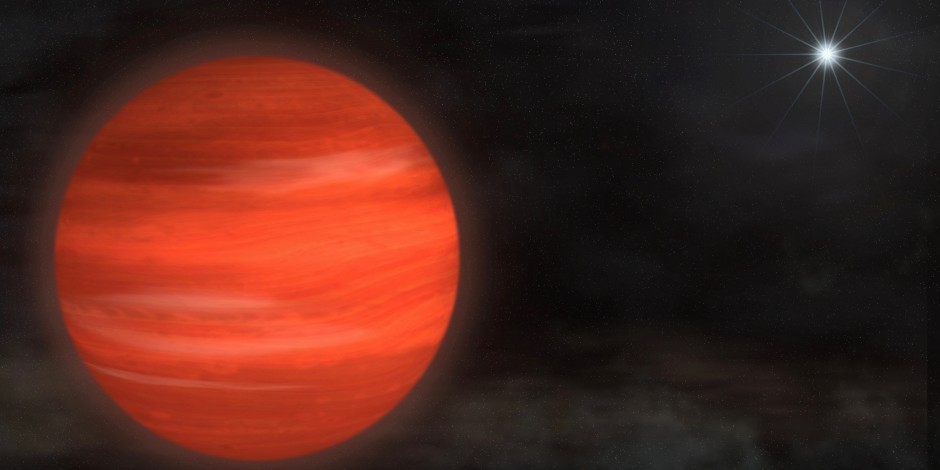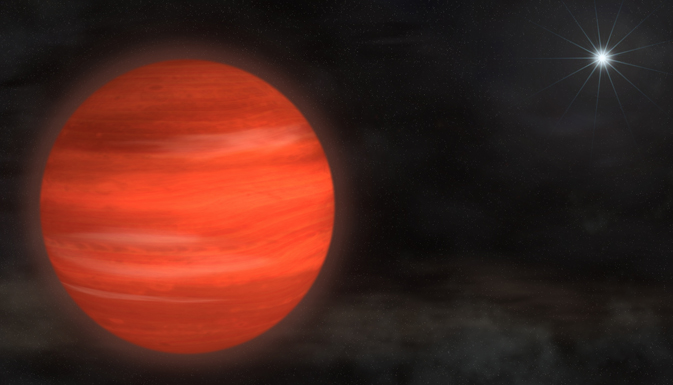Water in the atmosphere of a Super-Jupiter

Kappa Andromedae b is one of the few substellar objects outside our Solar System that has been directly photographed. Whereas astronomers still debate as to whether the object is an exoplanet or a brown dwarf, Kamen Todorov, member of the NCCR PlanetS at ETH Zürich, and colleagues measured the amount of water vapour in the atmosphere of κ And b analysing its spectrum of refracted light. The result may help in determining the formation mechanism of giant exoplanets as the team explains in a paper now accepted for publication by the Astrophysical Journal.

The “super-Jupiter” Kappa Andromedae b, shown here in
an artist’s rendering, circles its star at nearly twice the distance
that Neptune orbits the sun. With a mass about 13 times Jupiter’s, the
object glows with a reddish color. Credit: NASA’s Goddard Space Flight
Center/S. Wiessinger
“Our target is 10-60 times more massive than Jupiter and fairly young in cosmic terms – just a few tens or hundreds of millions of years,” explains Kamen Todorov, a postdoc at ETH Zürich. This means that κ And b is still about 1800 C hot and very slowly cooling with time. “Hence, any water would be strictly in vapour form,” says the astrophysicist. To measure the abundance of water Todorov’s team analysed data collected during observations by another group in 2013 using the Palomar Hale 5m telescope in Southern California. “They graciously shared their data with us, and the first author of that study, Dr. Sasha Hinkley of the University of Exeter, joined our team for this project,” says the PlanetS scientist.
The previous work of Hinkley’s team had resulted in a spectrum of refracted light of κ And b. “The brightness of the object varies with colour, and this caries information about the composition of its atmosphere,“ explains Kamen Todorov: “We took the spectrum and analysed it using a technique called ‘spectral retrieval’.“ This technique relies on calculating hundreds of thousands of model spectra by making guesses about the atmosphere of the target and then comparing each model to the observation. After each comparison, the astrophysicists adjust their guess in order to improve the match to the observations. This way, they are able to arrive at a model which “best fits” and describes the observations. This model contains information about the water vapour content and other parameters.
Looking for clues about the formation process
The abundance of water and other molecules in the atmospheres of exoplanets may help to determine their formation mechanism, as Kamen Todorov explains: “Planets are usually formed within a disk of gas and dust which surrounds a very young star, no more than about 10-15 million years.” Because of physical processes within that disk, planets that form in different parts of the disk (close to the star or further away) may have different total amounts of carbon and oxygen, also depending on the exact process of formation. “Comparing the ratio of carbon and oxygen atoms in the atmosphere of a planet or a brown dwarf can give us clues about how it formed and where in the disk,” says the astrophysicist: “Water, carbon dioxide, carbon monoxide and methane are the most common molecules that carry C and O, so we are most interested in counting those.”
In this case, the data were not quite good enough to determine the carbon dioxide, carbon monoxide and methane abundances, and hence the C/O ratio, well. But Kamen Todorov plans to extend his project to look into other similar objects that are even hotter or less hot and examine how the water abundance and C/O ratio change with temperature and distance from the central star. And Michael Meyer, leader of the NCCR PlanetS research project 1 “Disks & Planets” says: “We hope to coordinate our efforts in this area through the NCCR PlanetS and apply similar techniques to other directly imaged planets.“ (bva)
Reference:
Todorov, M. Line, J. Pineda, M. Meyer, S. Quanz, S. Hinkley, J. Fortney: The Water Abundance of the Directly Imaged Substellar Companion κ And b Retrieved from a Near Infrared Spectrum
http://arxiv.org/abs/1504.00217

